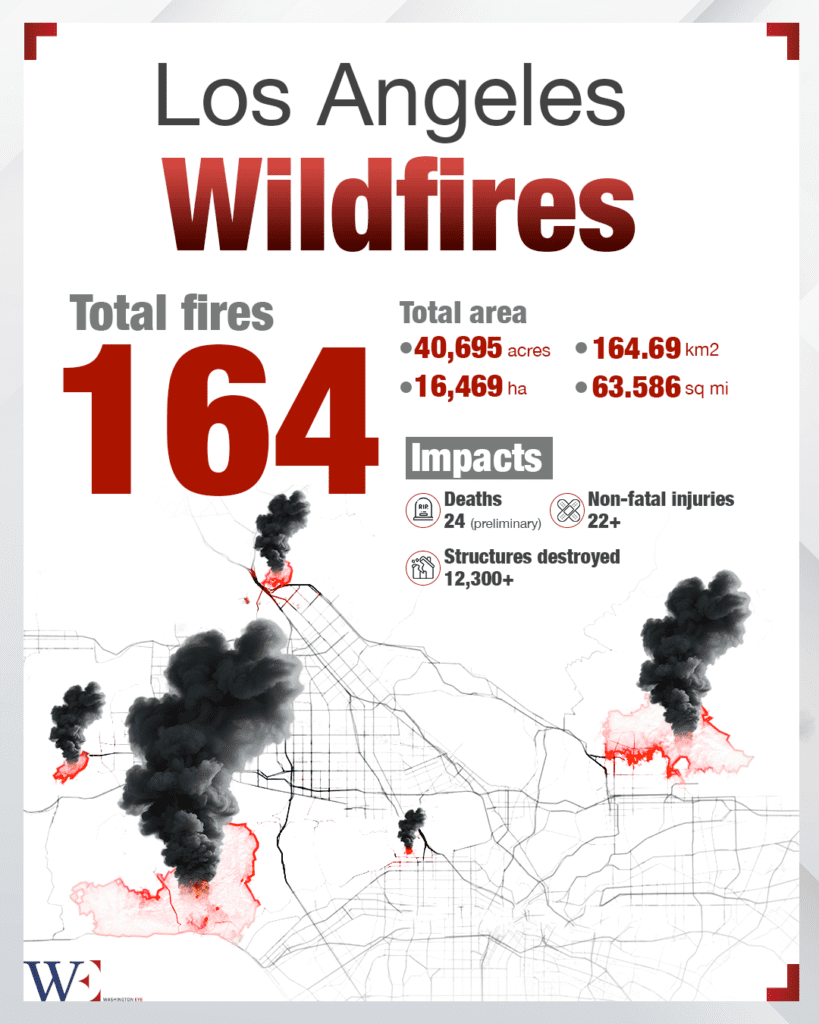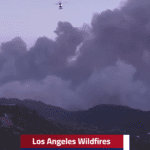The sprawling hills of Los Angeles have long been synonymous with glamour, scenic beauty, and the homes of Hollywood’s elite. But in recent weeks, they have become a battleground against an unrelenting wildfire in the Palisades region that erupted on January 3, 2025. As of today, the fire has expanded dramatically, threatening not only the cherished landscape but also the lives and properties of thousands.
Authorities have traced the origin of the wildfire to a remote canyon in the Pacific Palisades area, sparked by an unconfirmed cause—possibly linked to human activity or electrical faults. Fueled by extreme Santa Ana winds and an ongoing drought exacerbated by climate change, the blaze quickly spread to neighboring areas, including Malibu, Topanga, and Brentwood. Within 48 hours, the fire’s intensity had forced mass evacuations as firefighters faced a fierce uphill battle.
As of this week, the wildfire has consumed over 50,000 acres of land, with containment efforts hovering around 45%. The situation remains dire, with thick plumes of smoke blanketing much of the city, prompting air quality warnings. Over 3,000 firefighters, supported by aerial tankers and ground crews, tirelessly work to contain the flames. However, steep terrain and shifting winds have hampered their efforts.
Governor Gavin Newsom declared a state of emergency for Los Angeles County on January 4, enabling the swift mobilization of state and federal resources. “Our priority remains the safety of all Californians and their homes,” Newsom stated during a press conference. “We’re doing everything we can to combat this devastating fire.”
The toll of the wildfire is staggering. Nearly 20,000 residents have been evacuated, with many seeking refuge in temporary shelters established by the Red Cross and local authorities. Tragically, two lives have been lost, underscoring the human cost of the disaster. Among the victims was a local firefighter who succumbed to injuries sustained during the rescue efforts, and a long-time Palisades resident who was unable to evacuate in time. Their loss has cast a somber shadow over the community, with vigils planned to honor their memory. Dozens of injuries, primarily due to smoke inhalation and minor burns, have been reported, adding strain to local hospitals already dealing with the city’s seasonal flu surge.
In terms of property damage, over 200 structures—including homes, businesses, and public buildings—have been destroyed. Among the losses are several historic properties and multimillion-dollar residences, including a Brentwood estate owned by a prominent entertainment executive. The iconic Getty Center, renowned for its art collection and architectural brilliance, narrowly escaped devastation thanks to its state-of-the-art fire-resistant design.
The wildfire’s path has placed several high-profile homes in jeopardy, including those of celebrities such as Leonardo DiCaprio and Reese Witherspoon. While some have publicly shared their gratitude for the tireless efforts of first responders, others have pledged donations to assist recovery efforts. Ellen DeGeneres, who owns a home near Malibu, took to social media, writing, “Our hearts go out to everyone affected. We must come together to support each other and the brave firefighters on the front lines.”
The environmental toll is equally grim. Thousands of acres of natural habitat, home to diverse wildlife species, have been reduced to ashes. Experts warn that it could take decades for these ecosystems to recover fully, if at all. The economic impact is also monumental. Preliminary estimates suggest damages exceeding $1 billion, factoring in destroyed properties, firefighting costs, and disruptions to local businesses. Tourism—a major economic driver for Los Angeles—has also taken a hit, with several attractions closed due to fire risks and poor air quality.
Amid the devastation, stories of community resilience and heroism have emerged. Local businesses and non-profits have rallied to provide aid, with restaurants offering free meals to displaced families and shelters receiving donations of food, clothing, and supplies. Volunteers have worked around the clock, supporting evacuees and assisting with animal rescues. “It’s heartwarming to see the community come together in such a difficult time,” said Jessica Lopez, a volunteer at a Malibu evacuation center. “People are donating what they can, and that’s what gives us hope.”
While the immediate focus remains on containment and recovery, the wildfire has reignited debates about long-term solutions to mitigate wildfire risks. Fire officials have emphasized the need for better forest management practices, including controlled burns and vegetation clearance. “We’re seeing a new normal,” said Los Angeles Fire Department Chief Kristin Crowley. “Wildfires are becoming more frequent and intense, and we must adapt our strategies accordingly.” Climate change has also taken center stage in discussions, with advocates urging policymakers to prioritize sustainable energy solutions and emission reductions. “This is not just a local issue,” said climate scientist Dr. Raj Patel. “What’s happening in California is a wake-up call for the entire world.”
As firefighters continue their arduous work, the residents of Los Angeles hold their breath, hoping for a shift in weather conditions to aid containment efforts. Meanwhile, the road to recovery looms large, requiring coordinated efforts at local, state, and federal levels. The Palisades wildfire serves as a stark reminder of the fragility of even the most affluent and resilient regions. As Los Angeles grapples with the immediate crisis, it must also confront the larger challenge of safeguarding its future in an era of growing environmental uncertainty.












